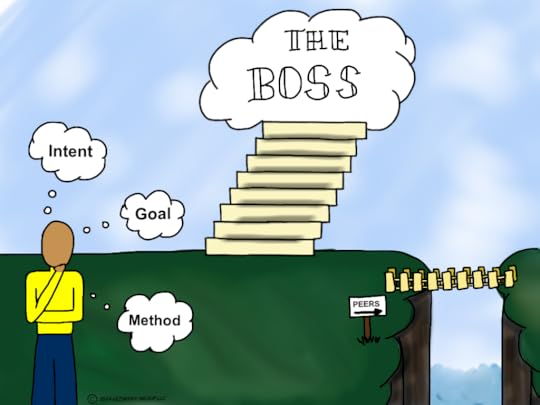David Dye's Blog, page 124
January 30, 2014
I Locked Up My Team and What Happened Next May Surprise You

A Leader’s Inspiration
I was sitting at the kitchen table eating a bowl of Honey Nut Cheerios.
At 11 years old, I was the oldest of six children. It was a warm Saturday in May, my mother was at work, and my father was running late. As he rushed through the kitchen on his way out the door, he stopped, pointed his finger in a sweep that took in the whole house, and said in a stern voice:
“David, this house is filthy. I want it spotless by the time I get home. You’re in charge. Now get it done and I’ll see you tonight.”
He didn’t say “or else…” but I understood this to be a serious matter.
I sat there, spoon in hand, and asked myself questions that will sound familiar to every leader:
What now?
How can I get everyone to do what has to be done?
What will happen if I don’t get it done?
I pondered these questions for several minutes and then…
Inspiration!
In a blinding flash of insight, I had it…
“CheriMaryEstherDannyRachael!” I hollered (it was an accomplishment to name everybody in one breath). “C’mon…everyone go downstairs. We’ve got to clean the house. Dad said so.”
Sometimes, I’m amazed that it worked: everyone trooped down to the basement. Everyone, that is, but me. Once everyone was downstairs, I climbed the stairs and…
I locked the door.
An interior door separated the stairs leading down to the basement from the rest of the house. I called down to my siblings, “I’ve locked the door – you can come out as soon as the basement is clean!”
Yes, that’s right.
My earliest leadership memory is of locking my younger brothers and sisters in the basement.
The Wrong Question
Nearly every time I share this story with audiences, at this point someone stops me and asks if they got the basement clean.
Let me ask you first – what do you think happened?
Before you read any further, take a moment and make your own guess.
Ready?
Well, the truth is, my team of five younger siblings did it. They put away the toys, threw out the trash, swept, and got it passably clean.
Are you surprised?
Many audience members are surprised that it worked. They expected some form of nonviolent (or violent!) protest.
To me however, asking if they cleaned the basement is the wrong question.
The better question is, “What happened next time?”
Results and Relationships
In my speaking, coaching, and training programs I meet many leaders who believe that “results are all that matter.”
Do any of these sound familiar to you?
I’d rather be a tyrant and meet my goals than lose my job.
The board hired me for one reason: to get results.
My boss doesn’t care if my team likes me, she only cares if I get things done.
You’ve probably heard someone, or even yourself, say something very similar.
It’s understandable. After all, it’s true: your team exists to achieve results. You were hired to achieve results.
Eleven-year-old me was certainly focused on results. Get the house clean!
Here’s the problem:
When you focus only on immediate results, you lock your team in the basement.
You may get immediate results through fear, power, and control, but the next time you need action, your team will trust you less. You’ll have to use even more fear and intimidation to get the same level of activity.
It’s a vicious cycle that ensnares many leaders (and one of the reasons employee engagement is so low).
That’s why “What happened next time?” is a better question.
Of course, you know the answer. My brother and sisters would never again trust my summons to the basement and I had to work hard to rebuild my credibility. (Several decades have passed and I still get teased about it 
Your sustained leadership success requires you to invest in healthy relationships with those you lead AND maintain a clear focus on results.
Anything less than that and you will find yourself on a treadmill: running faster and faster to stay in one place, continually replacing good people who leave, and relying on anger and fear to get anything done.
In contrast, organizations with healthy relationships and strong results feature motivated teams who take responsibility for their own work, stable turnover, and people accomplish amazing things by leveraging each other’s talents and strengths.
Which one do you want?
Your Turn
You’ll be able to build teams that care and get more done with fewer headaches when you invest in both results and relationships.
How do you manage the tension between results and relationships?
Take care,

David
If this post was helpful, check out my award-winning book The Seven Things Your Team Needs to Hear You Say. I provide leaders with practical tools you can use to build engaged, energized, and innovative teams. Get your copy today on Amazon.com.
David expertly nets it out for busy leaders (and is there any other kind these days?), sharing practical, actionable advice that will immediately transform leaders and improve team results. -Julie Winkle Guilioni, Co-Author of Help Them Grow or Watch Them Go
Make a difference twice: for every copy sold I donate one dollar to nonprofits that help people who need help the most.
You also might like:
Can’t Keep Up? Get More Time for Your Work and Work from Your Team
9 Ways to Motivate Employees When You Don’t Set the Goals
But I Thought We Were Friends – How to Lead Peers
18 Truths You Really Can’t Avoid If You Want to Stay Relevant, Effective, and Connected
How to Get Clarity, Accountability, and Results in 5 Minutes

Want to get more done & build teams that care?
Email David today or call 303.898.7018!
Creative Commons Photo Credit: dzarro72
The post I Locked Up My Team and What Happened Next May Surprise You appeared first on Leadership Speaker David Dye.
Book David today for your event, workshop, or training: david@trailblazeinc.com or 1.800.972.582
January 17, 2014
Experts on Leading Up and Sideways: A Frontline Festival

Your leadership success depends on your ability to get things done with a wide variety of people – most of whom are not members of your team. Your boss, your peers in other departments, vendors, customers, and even your family all play a role in your leadership success.
I’m honored to host this month’s Frontline Festival with a fantastic collection of wisdom on how to lead up and sideways. Thank you to the ever-generous leadership community for sharing your wisdom and insights!
Leading Sideways: Influence
Jesse Lyn Stoner, Seapoint Center, shares How to Influence Without Authority. Leadership today depends on the ability to work effectively across boundaries – to influence up, down, across and around without relying on reporting relationships. Develop these 8 sources of influence to lead without authority. Follow Jesse @JesseLynStoner
Julie Winkle Giulioni, JulieWinkleGiulioni.com, shares Before Competence. Before competence, there’s confidence. But before confidence, there’s frequently a leader who is willing and able to take steps to help others build trust, faith, and belief in their ability to succeed. Follow Julie on Twitter @Julie_WG.
Mary Kelly, PhD, Productive Leaders, shares Leading Across Divisions: The Perils of Stovepipe Retailing. Individual teams can meet their goals and yet their organization still fails. How can this be? Leadership expert, Mary Kelly, PhD provides the answer and where to put your focus in order to align departments and achieve success. Follow Mary on Twitter @marykellyspeaks.
John Hunter, Curious Cat Management Improvement Blog shares Circle of Influence. Prove yourself to be valuable and you will gain influence. Help people solve their problems. They will be inclined to listen to your ideas. Provide people useful management tools and help them apply them successfully. Join John on Twitter @curiouscat_com.
Bill Benoist, Leadership Heart Coaching shares The Influential Leader. The best leaders are multi-directional. They see leadership not only as downward, but upwards and sideways as well. Follow Bill @leadershipheart.
Kate Nasser, Smart SenseAbilitiesTM shares Leadership: 5 Easy Shifts to Engage Employees in Tough Times. To lead up or sideways, we as leaders must shift out of our ordinary gear and energize others. Here are 5 easy shifts to ignite employee commitment. Follow Kate @KateNasser.
Sean Glaze, Lead Your Team, shares How to GIVE Your Team Advice that Gets Results. One of the most difficult skills for a teammate or leader to learn is how to give people on your team advice that gets results instead of resentment. This articvle shares four steps to influencing your peers and team leaders that you can use immediately! Follow Sean @leadyourteam.
Leading Up: The Boss
Karin Hurt, Let’s Grow Leaders, (and founder of the Frontline Festival!) shares How to Persuade Your Boss. When you’re passionate about what must be done, it’s important to be able to persuade your boss to your point of view. Karin Hurt shares her PERSUADE model to help you communicate effectively with your boss. Follow Karin @letsgrowleaders
Robyn McLeod, Thoughtful Leaders Blog, shares Three Good Things I Learned From My Big Fat Horrible Boss. Robyn McLeod, Thoughtful Leaders Blog, shares Three good things I learned from my Big Fat Horrible Boss, a look back at her experience with a micro-managing boss and what it taught her about managing up and managing through difficulties. The post proves once again that positive lessons often come from negative experiences. Follow the Thoughtful Leaders on Twitter at @ThoughtfulLdrs.
Joan Kofodimos, Anyone Can Lead shares What’s Good About Having a Bad Boss? The experience of living with a bad boss may be frustrating, but there’s a silver lining – it’s also a valuable crucible for your own learning and growth as a leader. This post is about managing your boss AND managing yourself in this situation. Follow Joan @JoanKofodimos.
Wally Bock, Wally Bock’s Three Star Leadership, shares Help Your Boss Succeed. Helping your boss succeed just makes sense. It’s also a good career strategy. Follow Wally @WallyBock.
Chery Gegelman, Simply Understanding Blog, shares Leading Your New Boss and the “Old” One. Guest Post on SmartBlog on Leadership. Your leaders don’t know what you know, they can’t see what you see. No matter where you sit, it is your job to bring that understanding to them. Here’s how… Follow Chery @GianaConsulting.
Julie Pierce, Empowered by Pierce, shares 3 Ways to Lead Those Leading You. Are you leading up? Julie gives you 3 easy ways to increase your influence and value within your organization. Follow Julie @julie_pierce.
Matt McWilliams, Life. Leadership. Love. Learned the Hard Way, shares How to Get More Face Time With Your Boss. Inspired by a reader’s comment, he answers the question, “how do you ask for a one-on-one meeting with your boss?” Follow Matt @MattMcWilliams2.
Beyond the Boss
John Mertz, Thin Difference, shares Building Trust Between Generations – Six Ways. Leading sideways also means leading across the generations. To develop leaders and our leadership skills, we need to share experiences and build trust. Follow John @ThinDifference.
Kimunya Mugo, Lead By Choice, shares Down But Not Out: Becoming a Significant Leader at Home. If you are raising a family, or planning to, you need to check out Down But Not Out. This book takes you through a practical process of finding your significance and role of taking deliberate leadership at home, highlighting success factors as well as factors that commonly derail relationships and precipitate strife. Follow Kimunya @KimunyaMugo.
Collaboration
Mike Henry, Sr., Lead Change Group, shares The Collaborative Team Player. This post contains 4 attitudes of collaborative team players. A collaborative team player is someone who can turn others into peers and then interact with them in a way that achieves results. Follow Mike on Twitter @mikehenrysr.
Robert Elkington, Leadership, shares Ubuntu, Complexity and the Art of Humility in Leadership. This post discusses the powerful African Philosophy of Ubuntu, as exemplified in President Mandela, and its contribution to a more collaborative and humble leadership approach. Follow Robert @RobertElkington.
Tom Eakin, BoomLife – Values Driven Success, shares How to Perform First Aid On a Conflict. Provides insight on the organizational “infections” created when leaders do not allow conflict to be resolved and some tips on how to recognize and treat conflict and to prevent cultural wounds from festering. Follow Tom @goboomlife.
Ruth Schwartz, High Performance Advocates, shares I Am Not a Human Resource. Ever since I started working I’ve heard the term “Human Resources,” and every time I hear it I have a John Merrick moment: “I am not a Human Resource. I am a human being!” Imagine a work revolution that looks like this… Follow Ruth @highperformance.
Your Turn
We’d love to hear from you. Leave a comment and share with us:
How do you successfully lead up and sideways?
Also, in honor of Valentine’s Day, February’s Frontline Festival will be all about creating connections. New contributors welcome. Click here to submit your post for February’s Frontline Festival.
Take care and thank you for leading well!
David Dye
Be the Leader You Want Your Boss to Be
Special thanks for the custom artwork by Joy and Tom Guthrie at Vizwex Group, LLC!
The post Experts on Leading Up and Sideways: A Frontline Festival appeared first on Leadership Speaker David Dye.
Book David today for your event, workshop, or training: david@trailblazeinc.com or 1.800.972.582
December 30, 2013
Best of 2013 Leadership and Employee Engagement

Thank You
As the year draws to a close I want to thank you for reading, sharing, and – most of all – for choosing to lead well.
It’s an honor to be a part of your leadership journey!
Best of 2013
Here are the posts you and your peers made the top ten most read in 2013.
18 Truths You Really Can’t Avoid If You Want to Stay Relevant, Effective, and Connected
9 Things To Do When You Feel Alone
9 Ways to Motivate Employees When You Don’t Set the Goals
But I Thought We Were Friends – How to Lead Peers
How Can I Get My Team to Listen to Me the First Time, Every Time
Give Me 3 Minutes and I’ll Make You a Smarter Leader
The Most Important Decision You Make to Motivate Your Employees
7 Warning Signs You Should Not Lead
What to Do When a Leader’s Behavior is Damaging, Self defeating, or Ineffective
7 Leadership Tools for When Today Stinks and Tomorrow is Forever Away
Coming Attractions – Your Leadership Success
With the success of The Seven Things Your Team Needs to Hear You Say, I’m so excited for the coming year and a range of new tools and resources we’ll be making available.
Part of my commitment is to provide the tools you need in a format that works for you. Whether you prefer to read, listen, watch, or interact, in 2014 there will something for you!
Your Turn
As we wrap up 2013, what has been your most significant leadership moment? Was it something you learned? A success? A challenge? Leave a comment, share with all of us, and I’ll see you in 2014!
Take care,
David Dye

Want to get more done & build teams that care?
Email David today or call 303.898.7018!
If these posts were helpful, check out The Seven Things Your Team Needs to Hear You Say. This award-winning book provides you with practical tools you can use to build engaged, energized, and innovative teams. Get your copy today on Amazon.com.

David expertly nets it out for busy leaders (and is there any other kind these days?), sharing practical, actionable advice that will immediately transform leaders and improve team results. -Julie Winkle Guilioni, Co-Author of Help Them Grow or Watch Them Go
Creative commons photo credit: Amodiovalerio Verde
The post Best of 2013 Leadership and Employee Engagement appeared first on Leadership Speaker David Dye.
Book David today for your event, workshop, or training: david@trailblazeinc.com or 1.800.972.582



